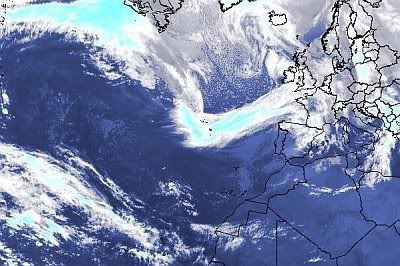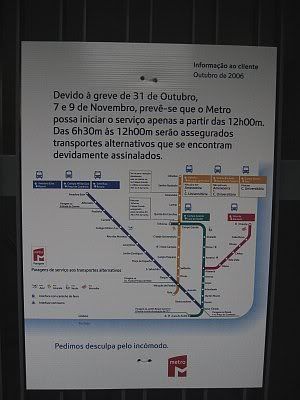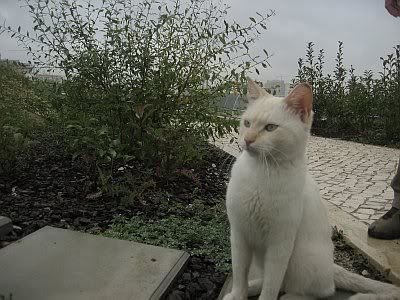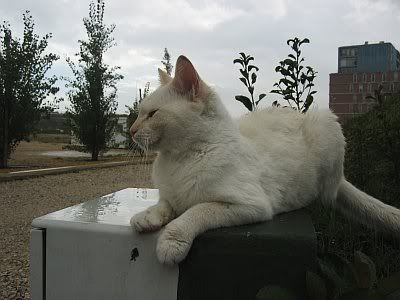O jornal “Público” noticiava esta manhã:
“Verbas cativadas por ordem das Finanças
Universidades públicas sem dinheiro para pagar subsídio de Natal”
Será isto o princípio do fim do país chamado Portugal?
O garrote financeiro aperta em tudo o que é organismo estatal. Ouvem-se vozes dizendo que a instituição A, B ou C tem os dias contados e que ano que vem só há dinheiro para pagar os salários.
O melhor, é a malta preparar-se para a mobilidade. E quem é que vai para a mobilidade?
Não se sabe ao certo. Aliás, nada se sabe ao certo neste país; continuamos mergulhados num nevoeiro sem saber em que direcção navegar, sem saber qual o porto de destino.
Assim é fácil governar: corta-se a percentagem que está a mais independentemente da qualidade do serviço ou da sua utilidade para a sociedade.
É fácil fazer dinheiro: os trabalhadores vão para casa com um corte de 30 % no ordenado, vende-se o património imobiliário a uma empresa que o irá comprar para fazer habitações de luxo e tudo fica resolvido.
Para quê a necessidade de cultura. Sim, essa palavra esquisita que é sinónimo de despesa. Se há cada vez menos gente que lê ou que entende o que lê é porque não necessitamos de Escolas, de Universidades, de Museus ou de outras instituições como estas gastadoras de recursos. A cultura deve ficar resumida às longas sessões de transmissões televisivas de jogos de futebol intercaladas com telenovelas cretinas e discursos da tanga dos nossos governantes. O povo português não precisa de mais nada!
segunda-feira, 27 de novembro de 2006
quarta-feira, 22 de novembro de 2006
Carga de chuva
Aí vem mais água (muita água) para regar as nossas couves:

Imagem meteosat de 22 de Novembro de 2006, pelas 21 horas retirada de http://www.meteo.pt/
A previsão deste acontecimento foi feita muito antes de ela se desenhar na atmosfera do nosso planeta. É formidável comprovar como a ciência meteorológica consegue prever os fenómenos atmosféricos com mais de uma semana de atecendência.

Imagem meteosat de 22 de Novembro de 2006, pelas 21 horas retirada de http://www.meteo.pt/
A previsão deste acontecimento foi feita muito antes de ela se desenhar na atmosfera do nosso planeta. É formidável comprovar como a ciência meteorológica consegue prever os fenómenos atmosféricos com mais de uma semana de atecendência.
domingo, 19 de novembro de 2006
O gato perdido no Parque Oeste (Alto do Lumiar)
segunda-feira, 13 de novembro de 2006
The biggest oil discovery in the last 30 years
Para quem como eu tem lido muita informação acerca do famoso “Peak Oil” fica um pouco confuso quando recebe uma notícia destas via e-mail:
"Saudi-Sized Oil Fields Found in Utah
“It’s the largest onshore
discovery in at least 30 years.”
~U.S. Department of Energy geologists
In the most important U.S. oil development in several
decades, 2 little-known companies are quietly preparing
to tap the largest on-shore oil field discovery since 1967.
The last time there was a discovery of this magnitude,
early investors made 150-times their money.
Dear Reader,
In Sevier County, Utah – a 3-hour drive from Salt Lake City – a small group of geologists have made the discovery of a lifetime...
It’s the largest onshore oil province discovered in the U.S. since Alaska struck it rich in 1967.
For investors, this offers a rare and very limited-time opportunity: a second chance to capitalize on soaring demand for oil around the world.
Just how much oil are we talking about in Utah?
“It's enormous – it's a major discovery,” says Steve Sonnenberg from the American Association of Petroleum Geologists.
“The size of the structures here are massive. They’re elephants,” says Kimball Hodges, a U.S. oil executive.
Recently, the U.S. Department of Energy made this official assessment:
“[This] discovery represents one of the most promising new onshore plays in the United States in recent years... The area has the potential to be a billion barrel province with perhaps another 10 fields to be discovered.”
This isn’t some hard-to-extract, oil shale field either.
This is pure light, sweet crude – the cheapest and easiest-to-refine oil in the world.
It’s the type of oil that put Texas on the map... and turned hundreds of wildcatters and thousands of American investors into millionaires.
What’s incredible is that this oil is so pure and plentiful, that even if oil prices dropped to levels not seen since 1980s prices, you could still turn a tidy profit on this Utah discovery.
Already, a small group of private investors are profiting from the first stake – a 480 acre-chunk of land that holds between 100-200 million barrels of light crude oil.
They’re already selling this oil to nearby Salt Lake refineries... and pocketing more than a million dollars a month.
But that’s just the beginning...
Drilling is set to begin on another section of this province. Preliminary reports suggest it could be 7-times as large... and could hold 1-3 billion barrels of oil.
The good news is you don’t have to be a private investor or fly to Utah to stake your claim.
Two of the companies set to drill this new oil province are publicly traded... and one of them “could be a 40-bagger,” according to Jack Galbraith, a money manager familiar with the situation.
The best part is, hardly anyone in the mainstream investment world knows about this discovery yet... except for local Utah papers like The Salt Lake Tribune.
In my 15 years in the field as a geologist, I’ve never come across a situation so amazing – both from a geological and an investment perspective.
I’ve written this letter to tell you everything I’ve learned about this discovery... including why it’s still a secret in the investment world, who’s drilling it... and how to take advantage of it — before the rest of the world finds out.
I can’t stress this enough: This story will NOT remain a secret for long. The people likely to make the most money are those who get in on this opportunity soon.
Here’s the full story...
Century-Old Oil Mystery –
Finally Solved
While exploring a 75-mile stretch of windswept land in Central Utah, a 25-man team called Wolverine Oil & Gas unearthed an enormous, multi-billion barrel oilfield.
According to Foreign Affairs, only about 1/5 of the oil left in the world is light crude.
It’s the largest onshore U.S. discovery since 1967, when geologists found oil in Prudhoe Bay, Alaska.
According to the Utah Division of Oil, Gas and Mining, this Utah oil is a very high quality light crude – the purest and most valuable oil in the world.
It’s the kind the Saudis sell to America... and it’s the kind Texas had in abundance in the 1930s.
But to have billions of barrels – right in the middle of the United States today – is incredibly rare...
You see, for close to a century, geologists have thought this part of Utah had plenty of oil.
Central Utah sits right on top of the North American Thrust Belt – a geological structure that slices through the continent... from Mexico, through Utah, and into the oil-rich fields of Alberta, Canada.
If you’re looking for oil, a thrust belt is the best place to start. Most of the world’s big oil discoveries have been along thrust belts.
Chevron, Shell, Amoco, and Gulf all made fortunes from major oilfields discovered along this thrust belt - in Wyoming and in parts of Utah.
But in Central Utah, not a single drop of oil has ever been found.
Chevron explored Central Utah for 25 years, with no success.
And in 1999, Chevron finally gave up, and sold their seismic data and land leases to Wolverine Oil & Gas - a privately held, Michigan-based company.
Douglas Strickland – Wolverine’s lead explorer and former Chevron geologist – figured out where everyone else had gone wrong.
Very simply, Strickland realized the surface rocks in this region were unlike any traditional oil markers.
Wolverine quickly – and quietly – uncovered this treasure trove... and now it’s only a matter of time before the region’s entire potential is fully tapped..."
Se confiarmos nesta notícia parece que os Estados Unido ainda possuem reservas de petróleo de boa qualidade no “onshore”, prontas para serem extraídas. Esta descoberta poderá moderar um pouco a subida vertiginosa do preço do ouro negro, evitando uma escalada dos preços das matérias-primas e dos produtos industriais que estão tão dependentes do preço do petróleo. Por outro lado, esta descoberta, poderá colocar mais um travão ao tímido desenvolvimento e comercialização de veículos menos poluentes movidos a combustíveis alternativos. Nesta caso o ambiente é que paga, claro!
"Saudi-Sized Oil Fields Found in Utah
“It’s the largest onshore
discovery in at least 30 years.”
~U.S. Department of Energy geologists
In the most important U.S. oil development in several
decades, 2 little-known companies are quietly preparing
to tap the largest on-shore oil field discovery since 1967.
The last time there was a discovery of this magnitude,
early investors made 150-times their money.
Dear Reader,
In Sevier County, Utah – a 3-hour drive from Salt Lake City – a small group of geologists have made the discovery of a lifetime...
It’s the largest onshore oil province discovered in the U.S. since Alaska struck it rich in 1967.
For investors, this offers a rare and very limited-time opportunity: a second chance to capitalize on soaring demand for oil around the world.
Just how much oil are we talking about in Utah?
“It's enormous – it's a major discovery,” says Steve Sonnenberg from the American Association of Petroleum Geologists.
“The size of the structures here are massive. They’re elephants,” says Kimball Hodges, a U.S. oil executive.
Recently, the U.S. Department of Energy made this official assessment:
“[This] discovery represents one of the most promising new onshore plays in the United States in recent years... The area has the potential to be a billion barrel province with perhaps another 10 fields to be discovered.”
This isn’t some hard-to-extract, oil shale field either.
This is pure light, sweet crude – the cheapest and easiest-to-refine oil in the world.
It’s the type of oil that put Texas on the map... and turned hundreds of wildcatters and thousands of American investors into millionaires.
What’s incredible is that this oil is so pure and plentiful, that even if oil prices dropped to levels not seen since 1980s prices, you could still turn a tidy profit on this Utah discovery.
Already, a small group of private investors are profiting from the first stake – a 480 acre-chunk of land that holds between 100-200 million barrels of light crude oil.
They’re already selling this oil to nearby Salt Lake refineries... and pocketing more than a million dollars a month.
But that’s just the beginning...
Drilling is set to begin on another section of this province. Preliminary reports suggest it could be 7-times as large... and could hold 1-3 billion barrels of oil.
The good news is you don’t have to be a private investor or fly to Utah to stake your claim.
Two of the companies set to drill this new oil province are publicly traded... and one of them “could be a 40-bagger,” according to Jack Galbraith, a money manager familiar with the situation.
The best part is, hardly anyone in the mainstream investment world knows about this discovery yet... except for local Utah papers like The Salt Lake Tribune.
In my 15 years in the field as a geologist, I’ve never come across a situation so amazing – both from a geological and an investment perspective.
I’ve written this letter to tell you everything I’ve learned about this discovery... including why it’s still a secret in the investment world, who’s drilling it... and how to take advantage of it — before the rest of the world finds out.
I can’t stress this enough: This story will NOT remain a secret for long. The people likely to make the most money are those who get in on this opportunity soon.
Here’s the full story...
Century-Old Oil Mystery –
Finally Solved
While exploring a 75-mile stretch of windswept land in Central Utah, a 25-man team called Wolverine Oil & Gas unearthed an enormous, multi-billion barrel oilfield.
According to Foreign Affairs, only about 1/5 of the oil left in the world is light crude.
It’s the largest onshore U.S. discovery since 1967, when geologists found oil in Prudhoe Bay, Alaska.
According to the Utah Division of Oil, Gas and Mining, this Utah oil is a very high quality light crude – the purest and most valuable oil in the world.
It’s the kind the Saudis sell to America... and it’s the kind Texas had in abundance in the 1930s.
But to have billions of barrels – right in the middle of the United States today – is incredibly rare...
You see, for close to a century, geologists have thought this part of Utah had plenty of oil.
Central Utah sits right on top of the North American Thrust Belt – a geological structure that slices through the continent... from Mexico, through Utah, and into the oil-rich fields of Alberta, Canada.
If you’re looking for oil, a thrust belt is the best place to start. Most of the world’s big oil discoveries have been along thrust belts.
Chevron, Shell, Amoco, and Gulf all made fortunes from major oilfields discovered along this thrust belt - in Wyoming and in parts of Utah.
But in Central Utah, not a single drop of oil has ever been found.
Chevron explored Central Utah for 25 years, with no success.
And in 1999, Chevron finally gave up, and sold their seismic data and land leases to Wolverine Oil & Gas - a privately held, Michigan-based company.
Douglas Strickland – Wolverine’s lead explorer and former Chevron geologist – figured out where everyone else had gone wrong.
Very simply, Strickland realized the surface rocks in this region were unlike any traditional oil markers.
Wolverine quickly – and quietly – uncovered this treasure trove... and now it’s only a matter of time before the region’s entire potential is fully tapped..."
Se confiarmos nesta notícia parece que os Estados Unido ainda possuem reservas de petróleo de boa qualidade no “onshore”, prontas para serem extraídas. Esta descoberta poderá moderar um pouco a subida vertiginosa do preço do ouro negro, evitando uma escalada dos preços das matérias-primas e dos produtos industriais que estão tão dependentes do preço do petróleo. Por outro lado, esta descoberta, poderá colocar mais um travão ao tímido desenvolvimento e comercialização de veículos menos poluentes movidos a combustíveis alternativos. Nesta caso o ambiente é que paga, claro!
terça-feira, 7 de novembro de 2006
Manhã pedonal
É manhã! O despertador toca! São 7 horas e 15 minutos! Um duche rápido, um pequeno-almoço reforçado, prepara-se a mochila com o essencial para o dia e ala, que se faz tarde, porque hoje é dia de greve de metropolitano.

Enquanto espero pelo elevador vou fazendo uns exercícios de aquecimento às pernas e aos pés porque hoje vou andar mais do que o habitual.
São 8 horas da manhã e como passo decidido e ritmado desço a Avenida Sérgio Vieira de Mello no Alto do Lumiar. Cruzo o Parque Oeste, passo pela Alameda da Música, atravesso o Parque das Conchas, desço a Rua Manuel Marques para chegar ao Campo Grande. Aí após atravessar os cruzamentos coalhados de veículos automóveis parados e a apitar freneticamente, entro no Jardim do Campo Grande. Mais adiante viro para oriente em direcção à Avenida de Igreja para chegar à Praça de Alvalade. Tomo a Avenida de Roma e como são ainda 9 horas da manhã aproveito para regalar com um sumo de uva no “Fruta Almeidas”. Descanso um pouco e quando o relógio se aproxima das 9 horas e 30 minutos entro no consultório do dentista. São 10 horas e 15 minutos e estou de novo na Avenida de Roma para mais uma caminhada. Dirijo-me para sul e viro à direita para percorrer a Rua Frei Amador Arrais. Ao fundo viro outra vez para sul e ultrapasso a linha de comboio (a linha de cintura). Rapidamente chego ao Campo Pequeno e daí é um saltinho até à Avenida 5 de Outubro. Com passo leve e rápido chego às Picoas para apanhar o fim da Avenida Fontes Pereira de Melo. O ar aqui é sempre irrespirável (cheira mesmo mal!). Entro na Praça Marquês de Pombal. As obras do túnel afastaram de vez os peões do centro desta praça. Depois de saudar o Marquês subo a Rua Braamcamp e rapidamente chego ao Largo do Rato. Entro na Rua da Escola Politécnica e finalmente chego ao meu destino: Museu de História Natural. São 11 horas e 5 minutos.

Ainda bem que o meu “carro” consome pouco aos 100 km!
Eis a potência máxima ao serviço do aquecimento global do planeta Terra:

Enquanto espero pelo elevador vou fazendo uns exercícios de aquecimento às pernas e aos pés porque hoje vou andar mais do que o habitual.
São 8 horas da manhã e como passo decidido e ritmado desço a Avenida Sérgio Vieira de Mello no Alto do Lumiar. Cruzo o Parque Oeste, passo pela Alameda da Música, atravesso o Parque das Conchas, desço a Rua Manuel Marques para chegar ao Campo Grande. Aí após atravessar os cruzamentos coalhados de veículos automóveis parados e a apitar freneticamente, entro no Jardim do Campo Grande. Mais adiante viro para oriente em direcção à Avenida de Igreja para chegar à Praça de Alvalade. Tomo a Avenida de Roma e como são ainda 9 horas da manhã aproveito para regalar com um sumo de uva no “Fruta Almeidas”. Descanso um pouco e quando o relógio se aproxima das 9 horas e 30 minutos entro no consultório do dentista. São 10 horas e 15 minutos e estou de novo na Avenida de Roma para mais uma caminhada. Dirijo-me para sul e viro à direita para percorrer a Rua Frei Amador Arrais. Ao fundo viro outra vez para sul e ultrapasso a linha de comboio (a linha de cintura). Rapidamente chego ao Campo Pequeno e daí é um saltinho até à Avenida 5 de Outubro. Com passo leve e rápido chego às Picoas para apanhar o fim da Avenida Fontes Pereira de Melo. O ar aqui é sempre irrespirável (cheira mesmo mal!). Entro na Praça Marquês de Pombal. As obras do túnel afastaram de vez os peões do centro desta praça. Depois de saudar o Marquês subo a Rua Braamcamp e rapidamente chego ao Largo do Rato. Entro na Rua da Escola Politécnica e finalmente chego ao meu destino: Museu de História Natural. São 11 horas e 5 minutos.

Ainda bem que o meu “carro” consome pouco aos 100 km!
Eis a potência máxima ao serviço do aquecimento global do planeta Terra:
Subscrever:
Mensagens (Atom)


